Running a financial-services business is about far more than moving money in and out of accounts — it’s about managing client trust, regulatory complexity, personalized advice, ongoing service relationships, and layered compliance. The challenge? CRM needs in the financial services industry are uniquely demanding. Firms must track high-value clients, nurture relationships over long horizons, monitor referrals and regulatory touches, segment based on asset classes or risk profiles, deliver timely compliance-safe email communication, and do all of this while maintaining a polished, secure, and scalable marketing system.
That’s where a thoughtful email marketing tool (or CRM with strong email capabilities) becomes a solution. When properly configured, a CRM becomes your operational backbone, enabling you to centralize client data, automate compliant email follow-ups, segment clients by product or asset class, trigger campaigns when life events or portfolio thresholds change, and maintain the audit trail and data governance necessary for financial services.
In this article, you’ll get:
- A comparison table of the top 10 email marketing tools (or CRM-email hybrids) suited to financial service businesses in 2025
- Feature breakdowns (for each tool, what it offers for automation, segmentation, compliance/record-keeping, reporting, integrations with financial systems, and mobile access)
- Real-world pros and cons, especially for companies in financial services (what works, what doesn’t, and what to watch out for)
- A step-by-step how-to guide for setting up email automations tailored to financial services (i.e., how to map workflows, design compliant templates, segment by client type and asset class, and measure performance)
- Tips for migration, measurement, and scaling (how financial services firms can move from spreadsheets or generic tools to a best-in-class email/CRM setup, how to measure ROI, and how to scale the system for growth or acquisitions)
It’s also worth noting that real financial services companies already use HubSpot. In the following sections, we’ll examine how other tools compare to HubSpot (and each other) and identify which ones offer the best fit for financial services marketers and operations teams in 2025.
Table of Contents
- What is email marketing for financial service businesses?
- Best Email Marketing Tools for Financial Service Businesses at a Glance
- Best Email Marketing Software for Financial Service Businesses
- Benefits of Email Marketing Software for Financial Service Businesses
- How to Choose an Email Marketing Tool for Financial Service Businesses (Step-by-Step)
- How to Create Email Marketing Campaigns for Financial Service Businesses
- Frequently Asked Questions (FAQ)
- Meet HubSpot, the Top Email Marketing Choice for Financial Service Companies
What is email marketing for financial service businesses?
Email marketing for financial service businesses is the practice of using targeted, permission-based email communication to build trust, educate clients, and nurture long-term relationships in a regulated industry. Unlike retail or eCommerce campaigns that focus on quick conversions, email marketing in financial services emphasizes credibility, compliance, and consistency.
Advisors, lenders, and wealth managers use email to deliver timely market insights, policy updates, product announcements, and personalized advice — all while maintaining strict data privacy and communication standards. The goal isn’t just to sell a service; it’s to position your firm as a trusted advisor who provides ongoing value and transparency.
When done right, email marketing becomes a scalable way to:
- Strengthen client relationships through personalized, compliant communication
- Automate onboarding, reminders, and follow-ups
- Keep clients informed about financial trends, products, and milestones
- Convert leads into loyal, long-term customers
In short, email marketing for financial service businesses bridges the gap between relationship-driven trust and digital efficiency, helping firms deliver the right message to the right client at the right time.
Best Email Marketing Tools for Financial Service Businesses at a Glance
|
CRM |
Best For |
Key Features |
Pricing |
Free Trial |
|
Complete financial services marketing automation with enterprise-grade compliance |
Advanced email segmentation for client portfolios Built-in compliance tracking and audit trails AI-powered send time optimization Automated lead scoring for high-value prospects GDPR/CCPA compliance tools Breeze AI for content personalization Multi-touch attribution reporting Native integration with financial data platforms |
Free: $0/month/seat Starter: $9/month/seat Professional: $800/month/seat Enterprise: $3,600/month/seat |
Yes, 14 days |
|
|
Large financial institutions needing industry-specific CRM |
Pre-built financial data models Household relationship mapping Compliance documentation workflows Einstein AI for predictive analytics Wealth management dashboards Insurance policy tracking |
Financial Services Cloud (Sales): $325/user/month Financial Services Cloud (Service): $325/user/month Financial Services Cloud (Sales and Service): $350/user/month Financial Services Cloud Agentforce 1 (Sales): $750/user/month Financial Services Cloud Agentforce 1 (Service): $750/user/month |
Yes, 30 days |
|
|
Small to mid-sized financial advisory firms |
Pre-built financial data models Household relationship mapping Compliance documentation workflows Einstein AI for predictive analytics Wealth management dashboards Insurance policy tracking |
Standard: $14/month Professional: $23/month Enterprise: $40/month Ultimate: $52/month |
No, demo only |
|
|
Sales-focused financial advisors and brokers |
Visual sales pipeline Activity-based selling Revenue forecasting Email tracking and templates Smart contact data enrichment Workflow automation builder |
Custom pricing only (see here) |
Yes, 14 days |
|
|
Enterprise financial services with existing Microsoft infrastructure |
Unified customer profiles Regulatory compliance management Power BI integration Customer insights AI Outlook and Teams integration Financial services accelerators |
Free: $0/user/month Dynamics 365 Business Central Essentials: $70/user/month Dynamics 365 Business Central Premium: $100/user/month Dynamics 365 Business Central Team Members: $8.00/user/month |
Yes, 30 days |
|
|
Independent financial advisors and RIAs |
SEC/FINRA compliance features Task workflow automation Email archiving Client meeting scheduler Investment account linking Mobile-first design |
Basic: $59/user/month Pro: $75/user/month Premier: $99/user/month Enterprise: Custom pricing only (see here) |
||
|
Wealth management and financial planning firms |
Integrated compliance archive Client portal with document vault Seminar management tools Commission tracking Custodian integrations Workflow automation |
Launch: $45/month Growth: $65/month Enterprise: Custom pricing only (see here) |
Yes, 30 days |
|
|
Small financial service businesses focused on automation |
Appointment scheduling Pipeline automation Smart forms and landing pages Text messaging Quote and invoice management Lead capture tools |
*Note: Pricing varies based on the number of subscribers, the pricing plans below are based on a 1,500-subscriber amount 2 users/1500 contacts: $299/month |
Yes, 14 days |
|
|
Financial marketers needing sophisticated email automation |
Predictive sending Split testing automation Site tracking Attribution reporting Lead scoring SMS marketing Custom reporting dashboards |
Starter: $15/month Plus: $49/month Pro: $79/month Enterprise: $145/month |
Yes, 14 days |
|
|
Financial teams using Google Workspace |
Native Gmail integration Automatic contact enrichment Pipeline management Project tracking Document management Workflow automation Chrome extension |
Starter: $12/month Basic: $29/month Professional: $69/month Business: $134/month |
Yes, 14 days |
Best Email Marketing Software for Financial Service Businesses
1. HubSpot
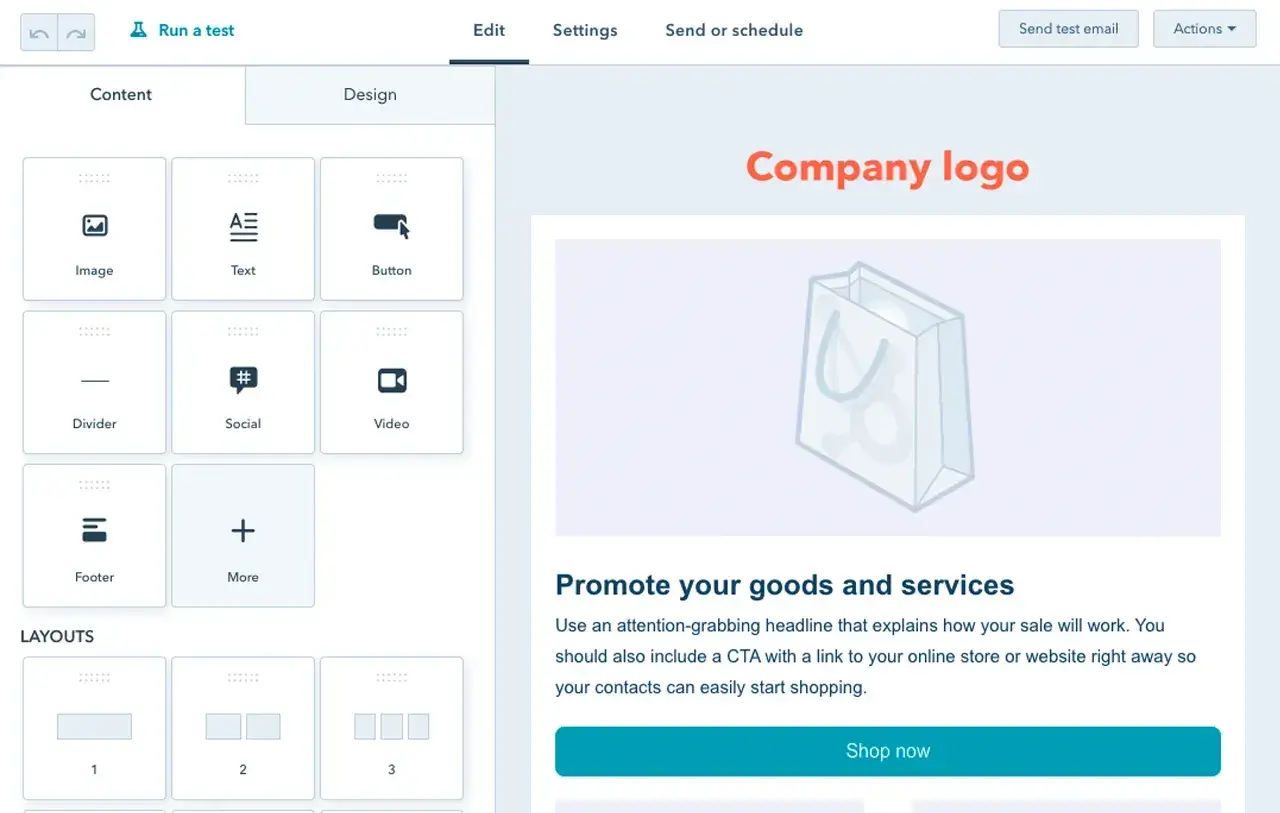
Best For: Financial service businesses needing comprehensive marketing automation with built-in compliance tools.
Key HubSpot Features:
- HubSpot’s AI-powered email segmentation: Financial advisors can automatically segment clients by portfolio size, risk tolerance, and life stage, ensuring personalized communication.
- HubSpot’s automated compliance workflows: Built directly into the email creation process, HubSpot’s compliance tracking integrations capture approval chains and maintain audit trails required for SEC and FINRA regulations.
- HubSpot’s Breeze AI integration with financial data platforms: Seamlessly connects with platforms like Creditsafe and Causal, allowing Breeze AI to generate personalized market insights and automatically trigger relevant email campaigns based on market movements.
- Free: $0/month/seat
- Starter: $9/month/seat
- Professional: $800/month/seat
- Enterprise: $3,600/month/seat
2. Salesforce Financial Services Cloud
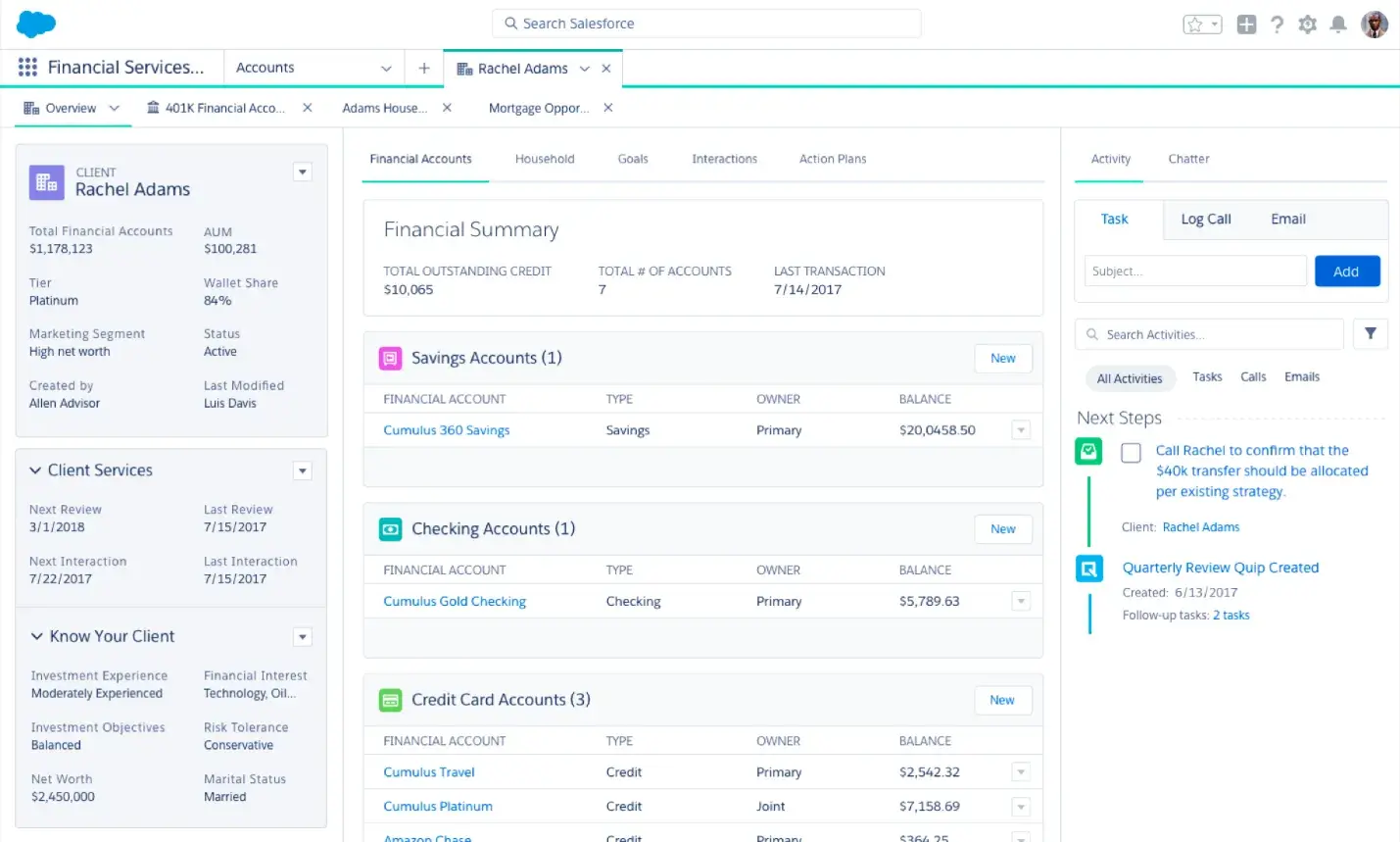
Best For: Large banks and insurance companies requiring enterprise-scale relationship management with regulatory compliance.
Key Salesforce Financial Services Cloud Features:
- Household relationship mapping: Critical for wealth managers who need to view entire family financial ecosystems, tracking multiple accounts, beneficiaries, and trust relationships.
- Einstein AI predictive analytics: Automatically scores leads based on likelihood to convert for specific financial products, helping advisors prioritize outreach to prospects most likely to need retirement planning or investment services.
- Pre-built compliance documentation workflows: Integrates with DocuSign and Adobe Sign to automate KYC (Know Your Customer) processes, reducing onboarding time from days to hours while maintaining regulatory standards.
Salesforce Financial Services Cloud Pricing:
- Financial Services Cloud (Sales): $325/user/month
- Financial Services Cloud (Service): $325/user/month
- Financial Services Cloud (Sales and Service): $350/user/month
- Financial Services Cloud Agentforce 1 (Sales): $750/user/month
- Financial Services Cloud Agentforce 1 (Service): $750/user/month
3. Zoho CRM for Finance
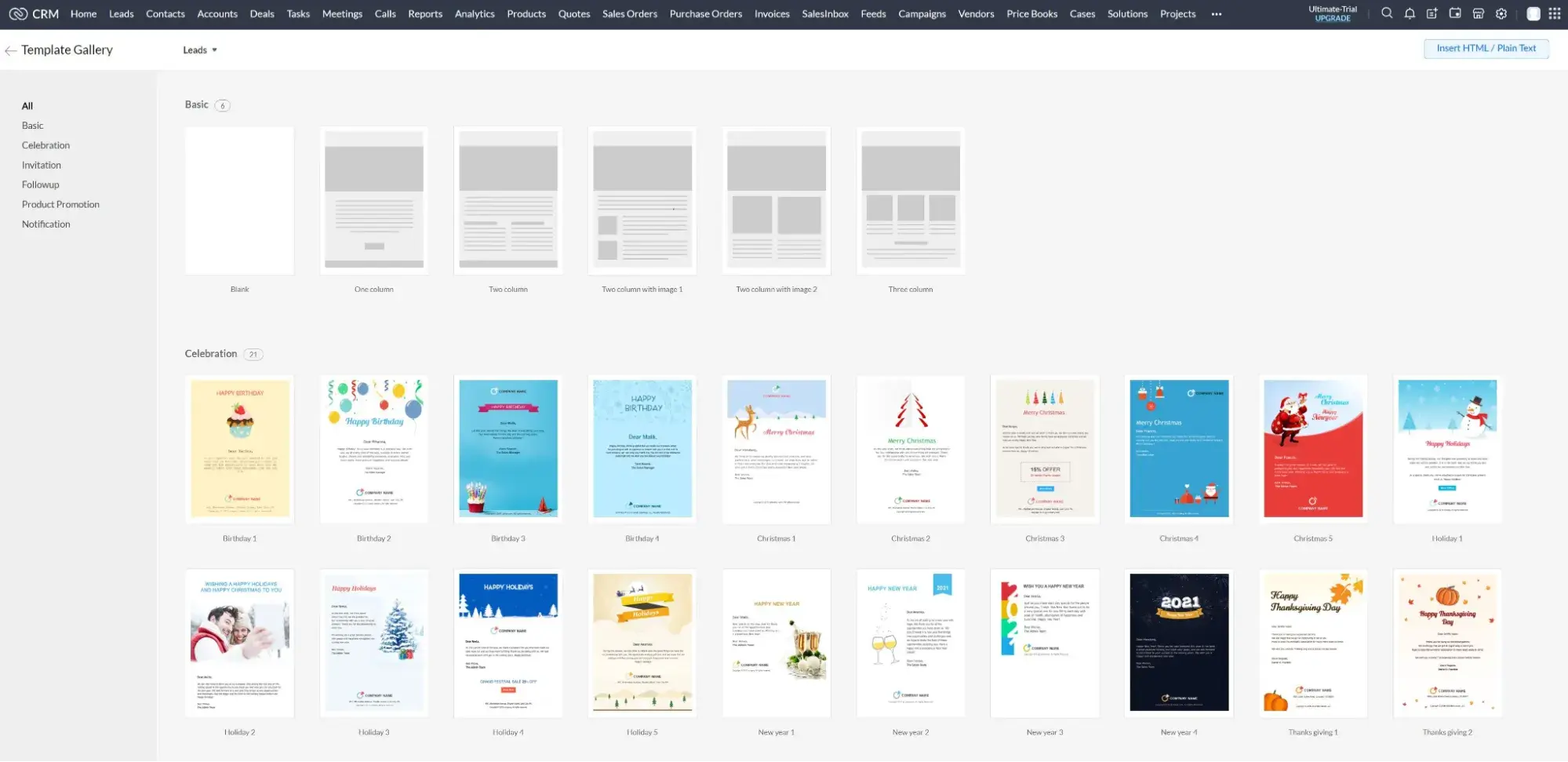
Best For: Small financial advisory firms needing affordable CRM with document management capabilities.
Key Zoho CRM Features:
- Built-in commission tracking: Automatically calculates advisor commissions based on product sales and AUM changes, essential for RIAs managing multiple fee structures and revenue streams.
- Client portal with e-signatures: Streamlines account opening workflows by allowing clients to review, sign, and submit documents digitally.
- Financial calculator integrations: Native connection to mortgage, retirement, and investment calculators that auto-populate CRM fields, enabling advisors to run scenarios during client meetings and save results directly to contact records.
Zoho CRM Pricing:
- Standard: $14/month
- Professional: $23/month
- Enterprise: $40/month
- Ultimate: $52/month
4. Pipedrive
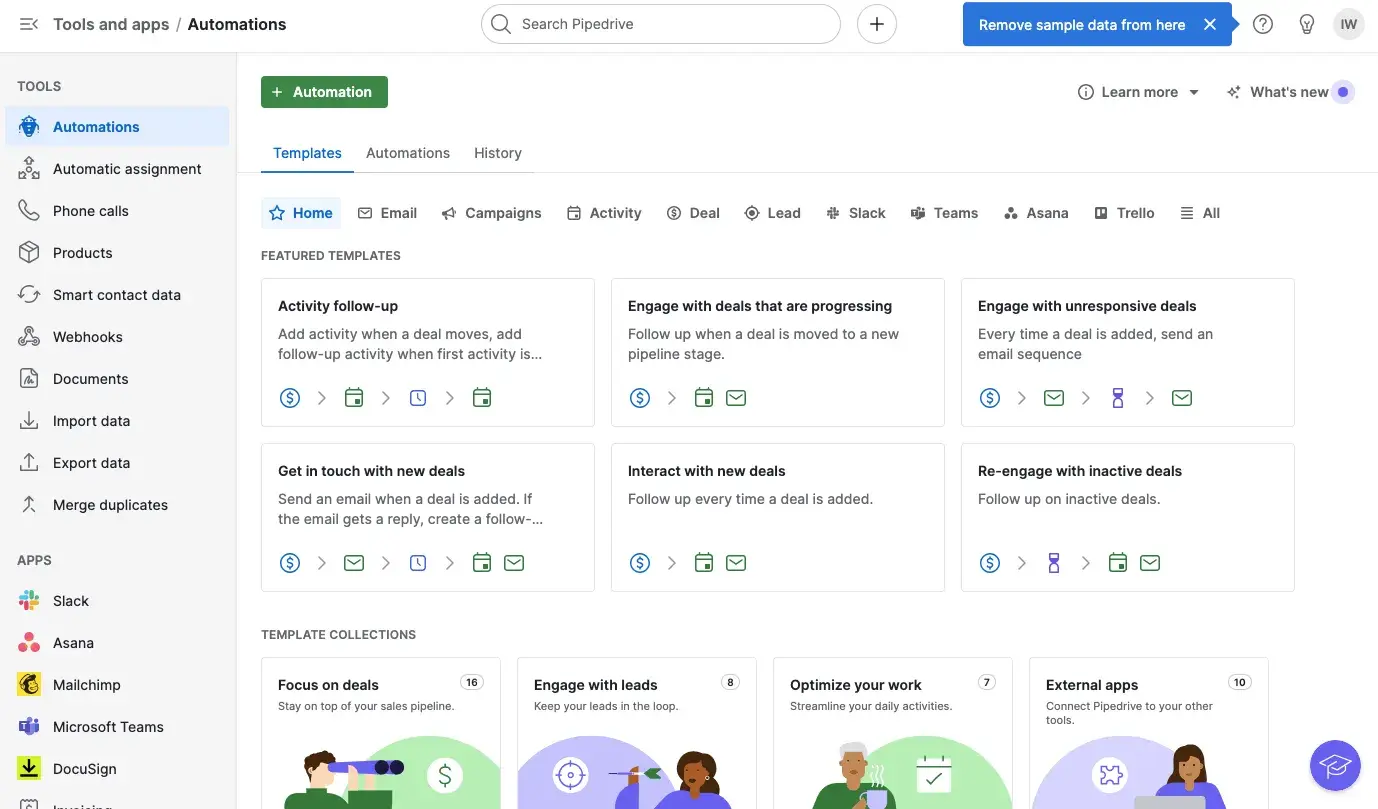
Best For: Independent insurance brokers and financial sales teams focused on pipeline velocity
Key Pipedrive Features:
- Visual sales pipeline for policy tracking: Insurance agents can drag-and-drop policies through underwriting stages, instantly seeing bottlenecks.
- Smart contact data enrichment: Automatically pulls financial data from public sources and LinkedIn, giving advisors instant context about prospect employment changes or company IPOs that signal investment opportunities.
- Activity-based selling automation: Triggers follow-up sequences based on prospect actions (like downloading retirement guides or attending webinars).
Pipedrive Pricing:
- Custom pricing only (see here)
5. <a href="https://www.microsoft.com/en-us/dynamics-365">Microsoft Dynamics 365</a>
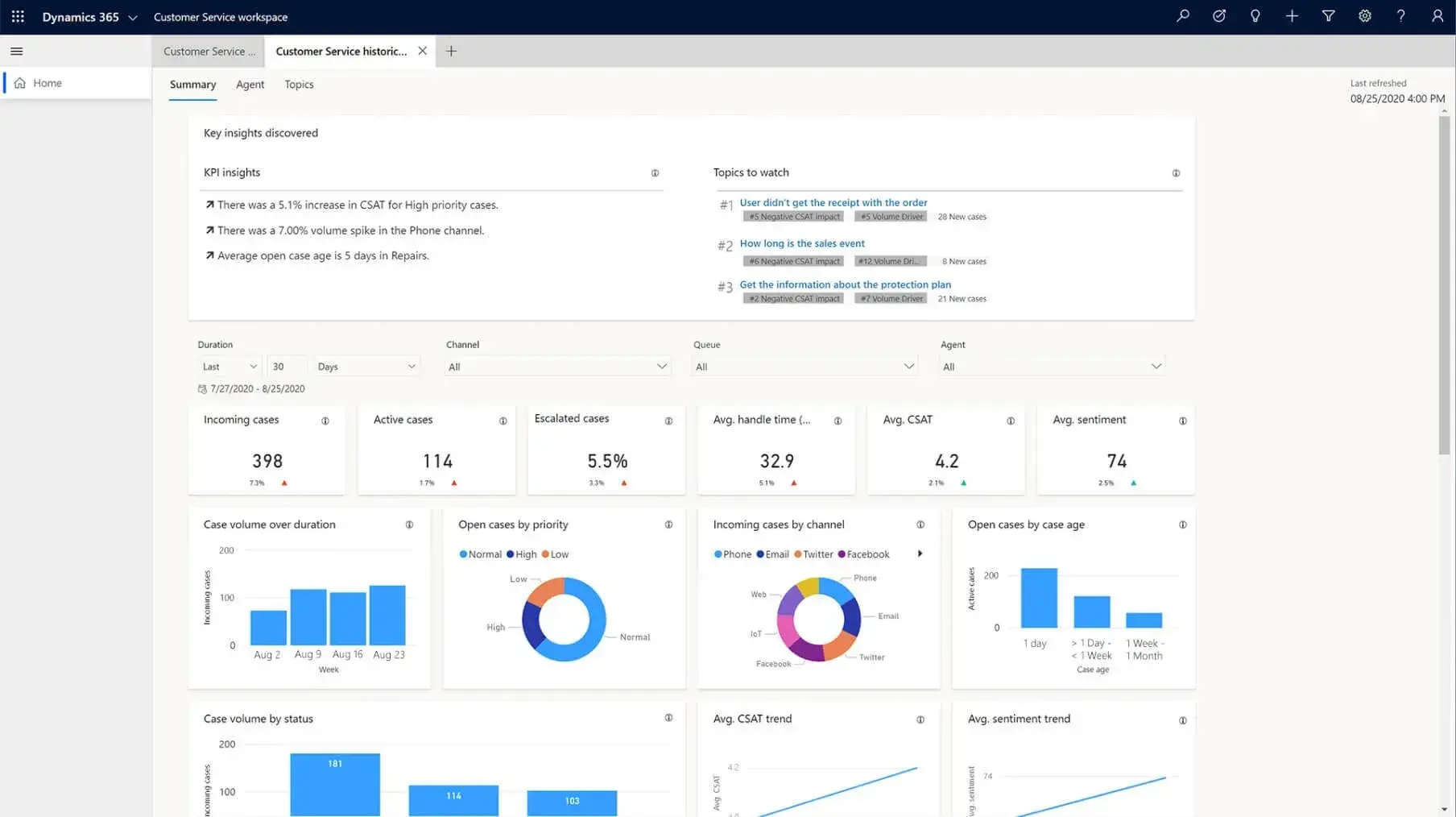
Best For: Enterprise financial institutions already invested in Microsoft’s ecosystem, requiring seamless Office integration.
Key Microsoft Dynamics 365 Features:
- Power BI integration for portfolio analytics: Financial advisors can embed real-time portfolio performance dashboards directly in client records.
- Regulatory compliance management module: Specifically designed for financial services, tracking MiFID II, GDPR, and Dodd-Frank requirements with automated alerts for compliance deadlines and documentation requirements.
- Teams integration for client collaboration: Enables secure video consultations with screen sharing for portfolio reviews, with automatic meeting notes and action items synced to the CRM record.
Microsoft Dynamics 365 Pricing:
- Free: $0/user/month
- Dynamics 365 Business Central Essentials: $70/user/month
- Dynamics 365 Business Central Premium: $100/user/month
- Dynamics 365 Business Central Team Members: $8.00/user/month
6. Wealthbox
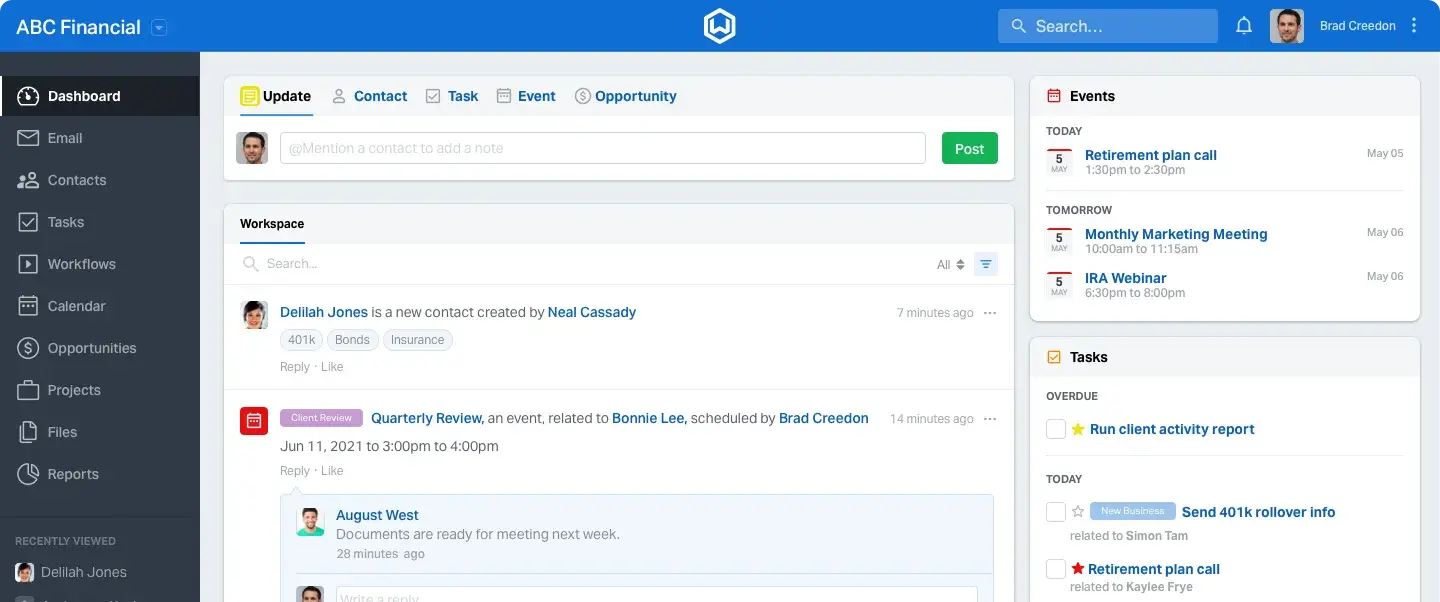
Best For: Registered Investment Advisors (RIAs) needing purpose-built wealth management tools with mobility.
Key Wealthbox Features:
- SEC/FINRA-compliant email archiving: Every client email is automatically archived and indexed for regulatory reviews.
- Investment account aggregation: Pulls real-time balances from custodians like Schwab and Fidelity, allowing advisors to see total AUM per client and trigger rebalancing workflows when allocations drift.
- Mobile-first task management: Advisors can update client meetings, log calls, and assign tasks from their phone between appointments, with offline sync ensuring no data loss in areas with poor connectivity.
Wealthbox Pricing:
- Basic: $59/user/month
- Pro: $75/user/month
- Premier: $99/user/month
- Enterprise: Custom pricing only (see here)
7. Redtail
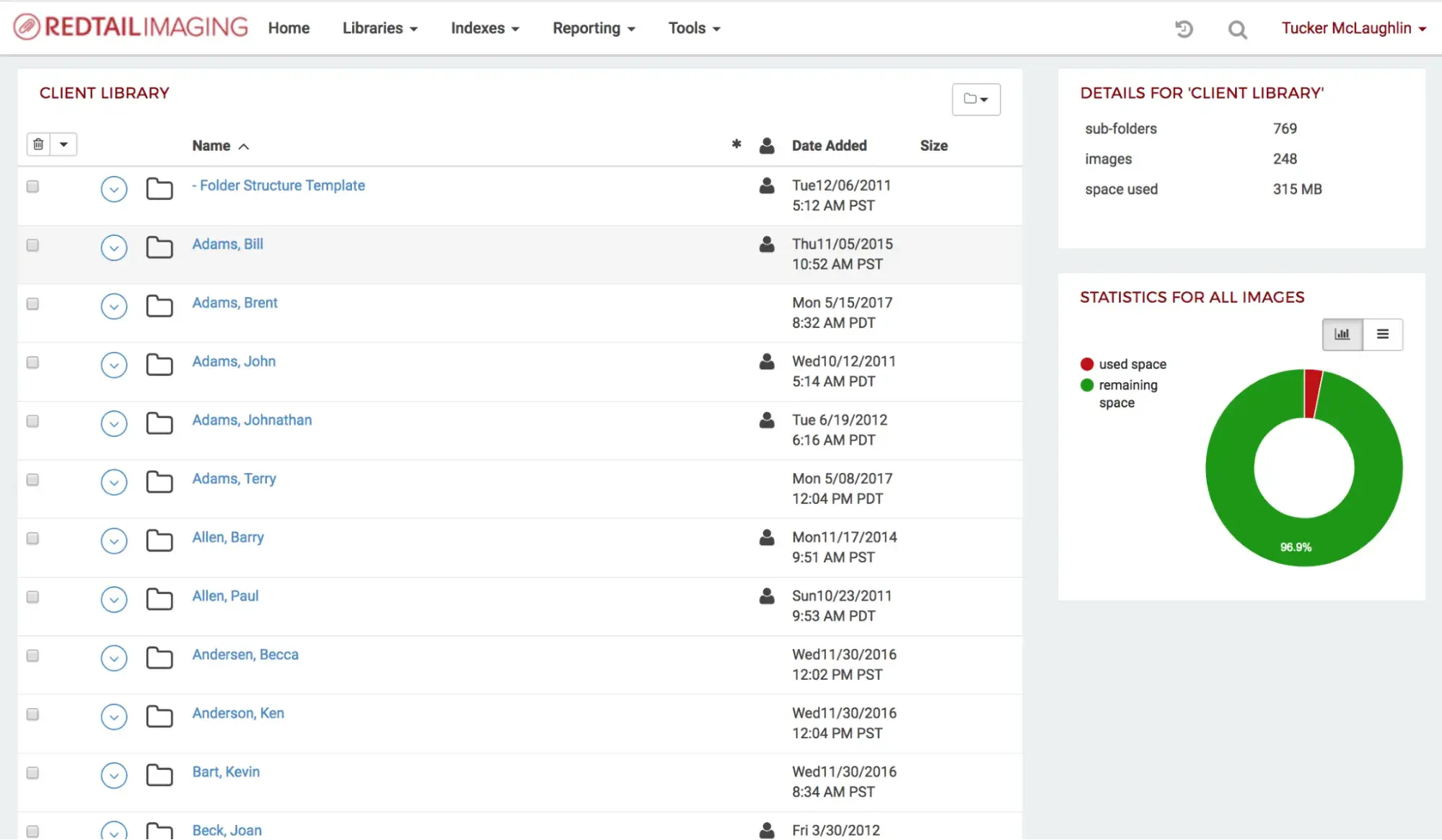
Best For: Traditional wealth management firms requiring deep custodian integrations and seminar management.
Key Redtail Features:
- Integrated compliance archive with keyword search: Critical for firms facing SEC audits, allowing instant retrieval of specific client communications using compliance keywords like “guarantee” or “performance.”
- Seminar management workflow: Automates the entire educational event process from invitation emails to RSVP tracking, attendance check-in, and post-event drip campaigns for retirement planning workshops.
- Direct custodian integrations: Bi-directional sync with TD Ameritrade, Pershing, and LPL Financial eliminates duplicate data entry and ensures account values update nightly for accurate reporting.
Redtail Pricing:
- Launch: $45/month
- Growth: $65/month
- Enterprise: Custom pricing only (see here)
8. Keap
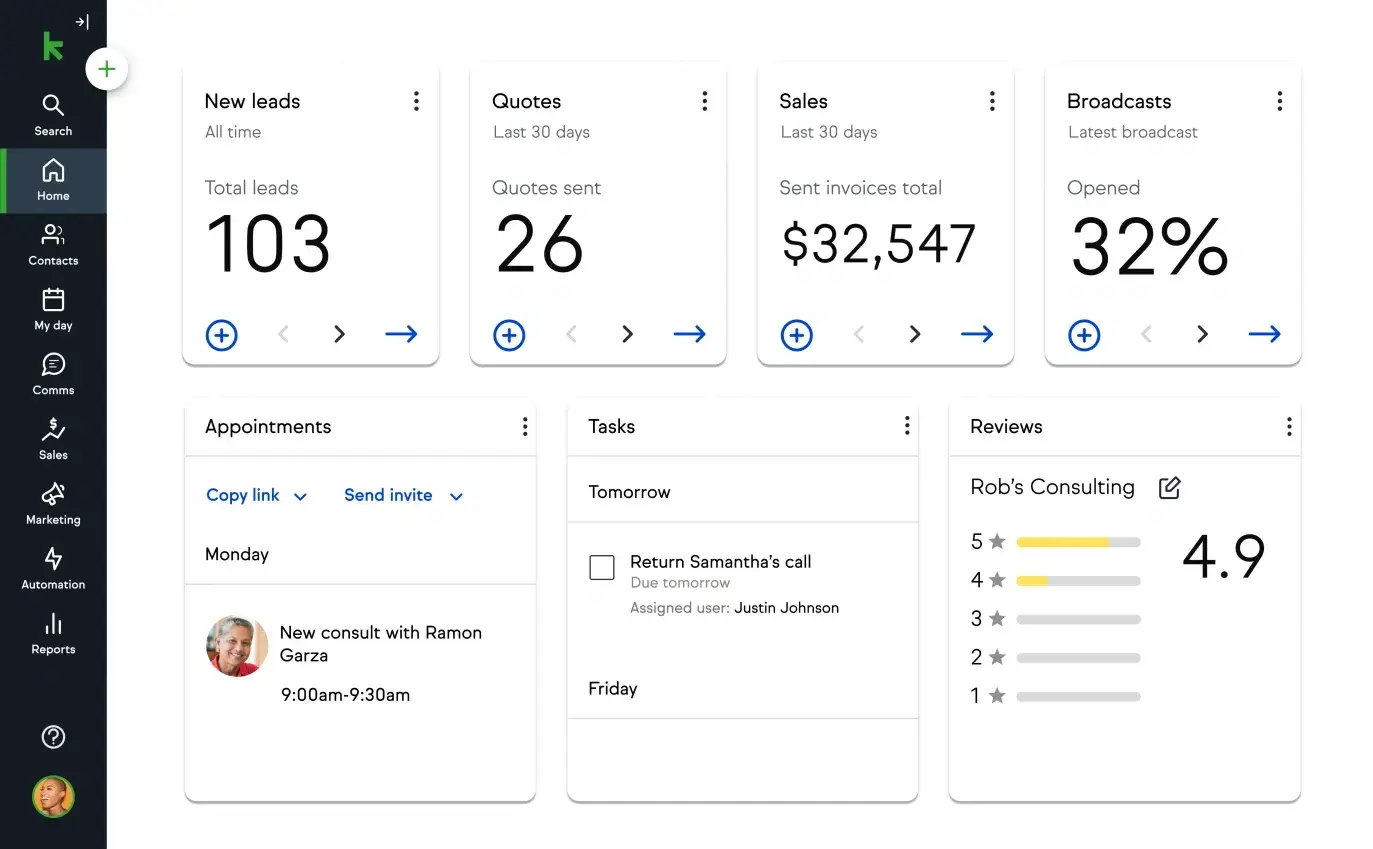
Best For: Solo financial advisors and small teams automating repetitive marketing tasks.
Key Keap Features:
- Appointment scheduling with buffer time: Essential for financial consultations that often run long, automatically blocking calendar time for prep and follow-up notes while sending reminder texts to reduce no-shows.
- Smart forms with conditional logic: Pre-qualification forms adapt based on responses, asking relevant questions about retirement goals or insurance needs, routing hot leads directly to calendars while nurturing others.
- Quote and invoice automation: Integrates with QuickBooks to generate fee proposals based on AUM tiers, automatically sending invoices for quarterly advisory fees and tracking payment status.
Keap Pricing:
*Note: Pricing varies based on the number of subscribers; the pricing plans below are based on a 1,500-subscriber amount
- 2 users/1500 contacts: $299/month
9. ActiveCampaign
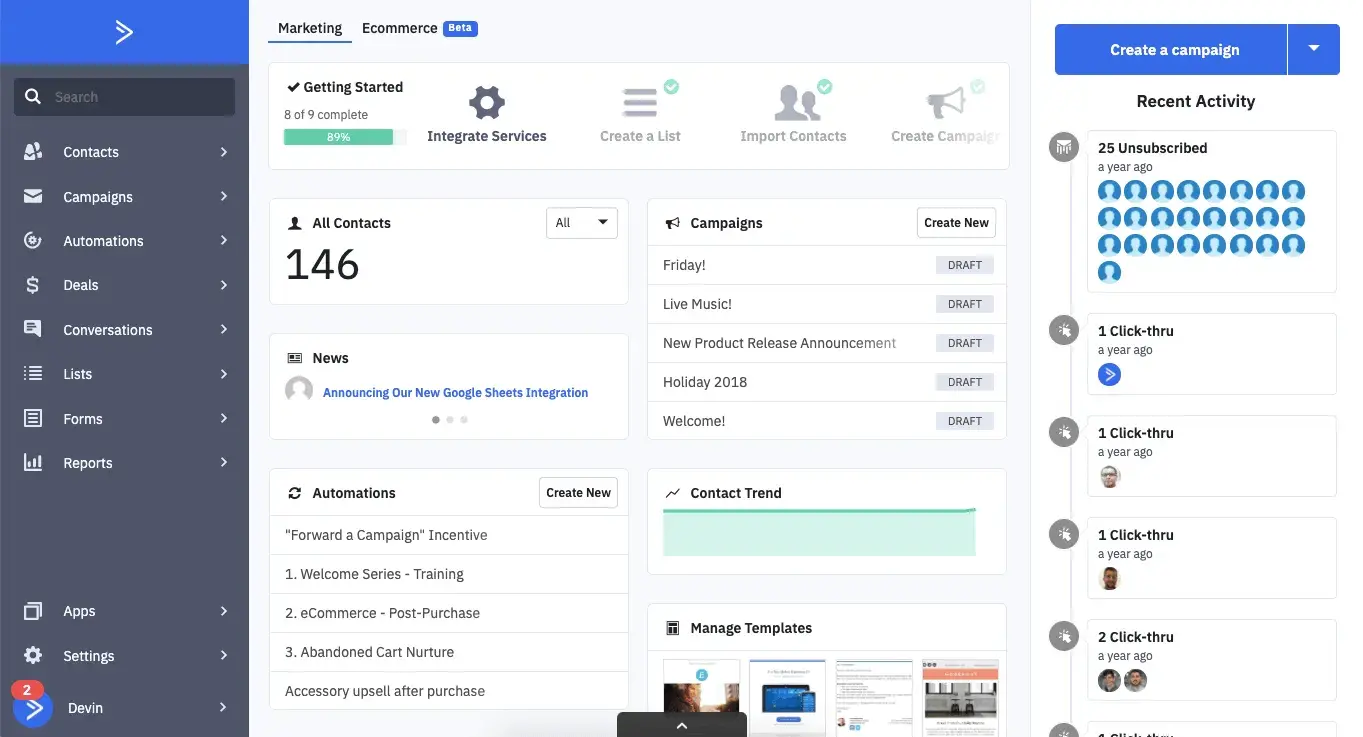
Best For: Financial marketers running sophisticated multi-channel campaigns with attribution tracking.
Key ActiveCampaign Features:
- Predictive sending for market updates: AI determines optimal send times for market commentary emails, crucial for when financial advisors need to reach clients before market open with timely insights.
- Multi-touch attribution reporting: Tracks which content pieces drive AUM growth, showing if clients who read retirement guides are more likely to rollover 401(k)s, justifying content marketing spend.
- Site tracking with lead scoring: Monitors which financial calculators and resources prospects use on your website.
ActiveCampaign Pricing:
- Starter: $15/month
- Plus: $49/month
- Pro: $79/month
- Enterprise: $145/month
10. Copper
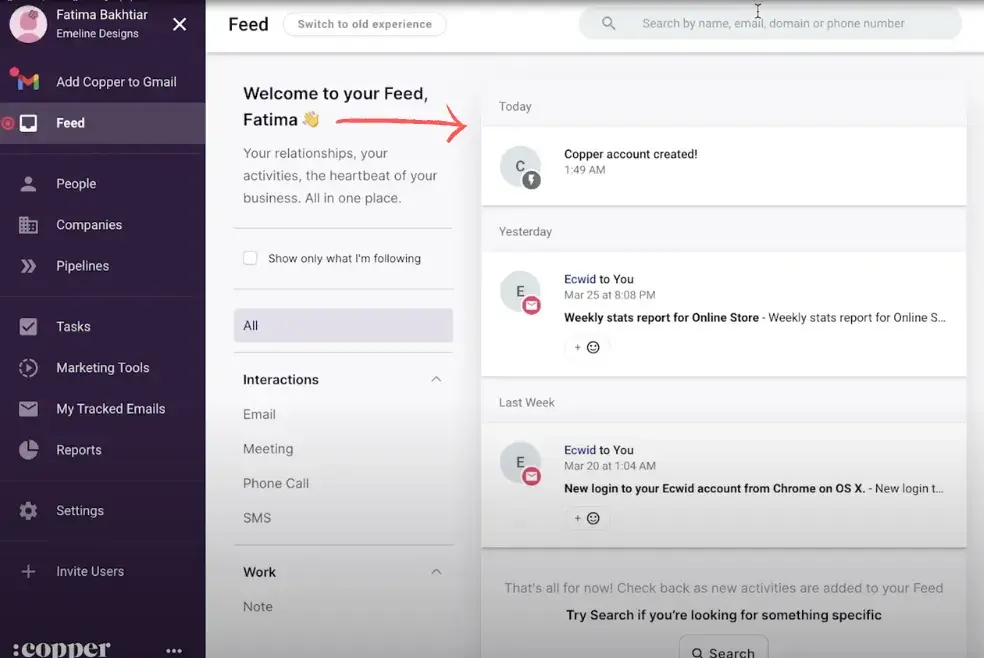
Best For: Financial teams using Google Workspace seeking zero-friction Gmail integration.
Key Copper Features:
- Native Gmail integration for compliance: Automatically logs every client email without plugins or BCC addresses, essential for advisory firms needing complete communication records for regulatory compliance.
- Automatic contact enrichment from Google: Pulls LinkedIn profiles and company data directly into contact records, helping advisors identify high-net-worth prospects based on job titles and company exits.
- Project tracking for client onboarding: Creates templated workflows for account opening, moving each new client through KYC verification, investment policy creation, and initial deposit tracking with deadline automation.
Copper CRM Pricing:
- Starter: $12/month
- Basic: $29/month
- Professional: $69/month
- Business: $134/month
Benefits of Email Marketing Software for Financial Service Businesses
Automated compliance documentation eliminates regulatory risk.
Financial service businesses face constant scrutiny from SEC, FINRA, and state regulators who require detailed documentation of all client communications. Manual tracking of email approvals, archiving conversations, and maintaining audit trails consumes hours of administrative time while leaving firms vulnerable to compliance violations that can result in hefty fines.
Plus, HubSpot’s compliance integrations can:
- Capture email interactions
- Log approval chains
- Maintain searchable archives that satisfy regulatory requirements
When advisors create emails in HubSpot, its compliance tracking features flag potentially problematic language, route content through designated compliance officers for pre-approval, and timestamp all modifications.
AI-powered personalization increases client engagement and AUM growth.
Financial advisors struggle to maintain personalized communication with hundreds of clients while managing portfolios, attending meetings, and staying current on market conditions.
Breeze AI analyzes client data including:
- Portfolio composition
- Life stage
- Past interactions to generate hyper-personalized email content that resonates with individual financial goals
For instance, HubSpot’s Breeze-generated subject lines can increase open rates by crafting messages like “John, your tech holdings outperformed the S&P by 12%” rather than generic “Q3 Market Update” subject lines.
Pro tip: HubSpot’s smart content rules dynamically adjust email sections based on client segmentsc (i.e., ensuring young professionals receive 401(k) maximization tips while retirees see RMD reminders).
Mobile CRM access enables real-time client service.
Financial advisors spend significant time outside the office meeting clients at their homes, attending networking events, or traveling between appointments, yet critical client information often remains trapped on desktop systems. This disconnect leads to missed opportunities when advisors can’t access portfolio details during impromptu client encounters or update meeting notes before details fade from memory.
HubSpot’s mobile CRM app provides complete access to client records, email history, and portfolio data from any device, allowing advisors to pull up account information during meetings or log touchpoints immediately after leaving a client’s office.
Integrated analytics prove marketing ROI and drive strategic decisions.
Financial marketing teams struggle to demonstrate how their email campaigns translate into actual AUM growth or new client acquisition, often relying on vanity metrics like open rates that don’t connect to revenue. Without clear attribution between marketing efforts and business outcomes, firms continue investing in ineffective strategies while missing opportunities to scale successful campaigns. Luckily, HubSpot’s multi-touch attribution reporting tracks the complete client journey, revealing exactly which content drives conversions.
For example, HubSpot’s revenue attribution dashboard can show that clients who engaged with retirement calculator emails subsequently rolled over an average of $450,000 in 401(k) assets, while those receiving only market commentary averaged $125,000 — providing clear direction for content strategy and budget allocation.
Workflow automation reduces administrative burden.
Financial service teams waste countless hours on repetitive tasks like sending appointment reminders, following up on incomplete applications, and manually segmenting clients for quarterly review outreach. This administrative overhead prevents advisors from focusing on high-value activities like financial planning and relationship building.
HubSpot’s workflow automation builder creates sophisticated trigger-based sequences that handle routine communications without human intervention, which automatically:
- Sends onboarding emails when prospects schedule consultations
- Triggers document reminders for unsigned forms
- Initiates birthday greetings with personalized portfolio milestone updates
Lastly, HubSpot’s customizable email templates maintains brand consistency while allowing quick personalization.
5 Important Features for Financial Planning Email Marketing Software
- Regulatory Compliance Management and Audit Trail Documentation: Financial planners must maintain meticulous records of all client communications to satisfy SEC, FINRA, and state regulatory requirements, with the ability to produce complete email histories during surprise audits. HubSpot's embedded security frameworks automatically archives every email interaction with tamper-proof timestamps, creates approval workflows that route marketing content through compliance officers before sending, and maintains searchable audit trails that can be exported in regulator-friendly formats.
- Mobile CRM Access with Offline Functionality: Financial planners frequently meet clients outside traditional office settings — at their homes for estate planning discussions, restaurants for prospecting lunches, or conference venues for educational seminars — requiring instant access to portfolio data and planning tools. Plus, HubSpot’s mobile CRM app provides complete functionality on iOS and Android devices, allowing planners to access client net worth statements, update meeting notes with voice-to-text transcription, and trigger follow-up email sequences directly from their phones.
- Advanced Pipeline Customization for Complex Financial Products: Financial planning involves multiple parallel pipelines — from 401(k) rollovers and life insurance applications to estate planning and college savings accounts — each requiring unique stages, timelines, and documentation. HubSpot’s customizable pipeline builder allows firms to create separate tracks for each financial product with industry-specific stages like “Risk Assessment,” “Underwriting,” “Carrier Selection,” and “Policy Delivery,” ensuring nothing falls through the cracks during lengthy sales cycles. HubSpot’s pipeline automation features automatically move opportunities through pipeline stages based on triggers like document submission or approval notifications, while the platform's probability weighting helps planners forecast commission income based on historical conversion rates for each product type.
- Sophisticated Email Automation with Behavioral Triggers: Financial planning requires nurturing prospects over extended periods — sometimes years — as they approach major life transitions like retirement, inheritance receipt, or business exits that trigger planning needs. HubSpot’s workflow automation processes create complex, multi-year drip campaigns that adapt based on prospect behavior, such as automatically intensifying communication frequency when someone downloads a free guide or resource. Plus, HubSpot’s behavioral scoring tracks engagement across email opens, link clicks, and website visits to identify when prospects transition from education mode to active decision-making, triggering alerts for planners to initiate personal outreach at optimal moments.
- Native Integrations with Financial Planning Ecosystem: Financial planners rely on specialized software for portfolio management, insurance quoting, and, of course, financial tools that must seamlessly exchange data with their CRM. HubSpot’s extensive integration marketplace includes pre-built connectors to major financial platforms, automatically syncing account values, investment performance, and planning projections to trigger relevant email campaigns. The bi-directional sync capabilities in HubSpot ensure that updates made in financial planning software — like revised retirement dates or beneficiary changes — automatically update CRM records and trigger appropriate email workflows, eliminating duplicate data entry while maintaining information consistency across all systems.
How to Choose an Email Marketing Tool for Financial Service Businesses (Step-by-Step)
Step 1: Map your workflows.
Start by documenting your financial service firm’s unique processes across client acquisition, onboarding, and retention cycles. Financial planners typically manage multiple parallel workflows, including:
- Initial consultation scheduling
- Risk assessment questionnaires
- Account opening documentation
- Quarterly portfolio reviews
- Annual planning meetings
Then, map out your current manual processes, identifying where emails are triggered (like after a prospect downloads a retirement guide), what approvals are needed (compliance review for market commentary), and which team members are involved at each stage. Consider the complexity of financial product sales cycles that can span months, requiring sophisticated nurture sequences that adapt based on life events like job changes, inheritance receipt, or approaching retirement dates.
Pro tip: Document integration points where your email marketing must connect with portfolio management systems, custodian platforms, and financial planning software to maintain data consistency.
Step 2: Identify must-have features.
Financial service businesses require specialized capabilities beyond standard email marketing, with regulatory compliance topping the list of non-negotiable features. Your platform must include:
- Automated email archiving with timestamps
- Pre-send compliance workflows that route content through designated officers
- Searchable audit trails that satisfy SEC and FINRA requirements during examinations
Look for behavioral tracking that identifies when prospects transition from research to decision mode — such as multiple retirement calculator uses or repeated visits to rollover guides — triggering timely advisor alerts. Additionally, mobile access is essential for advisors meeting clients outside the office, while advanced segmentation capabilities must handle complex criteria like asset levels, risk tolerance, age brackets, and product ownership. Ensure the platform offers dynamic content blocks that automatically adjust messaging based on client life stage.
Step 3: Compare ease of use and team fit.
Next, evaluate how quickly your team can become proficient with each platform, considering that financial advisors often have limited technical expertise and even less time for extensive training. Request hands-on trials where your actual team members (not just IT staff) create email campaigns, set up automation workflows, and generate compliance reports to assess real-world usability. Additionally, don’t forget to consider the learning curve for different user roles:
- Advisors need intuitive mobile interfaces for logging client interactions
- Marketing teams require drag-and-drop email builders with compliant templates
- Compliance officers need straightforward approval workflows with clear audit trails
Assess vendor support quality by testing response times with financial industry-specific questions about regulatory features, checking whether they offer dedicated onboarding specialists who understand financial services, and evaluating the depth of their knowledge base for self-service troubleshooting. Platform adoption succeeds when the interface feels familiar to users accustomed to financial software, with terminology that matches industry conventions like “AUM” instead of “deal size” and “client households” rather than “companies.”
Step 4: Check cost at scale.
Calculate the true cost of ownership beyond initial license fees, factoring in how pricing scales as your firm grows AUM, adds advisors, and expands client databases.
Many platforms charge per contact or email send, which can exponentially increase costs for financial firms maintaining large prospect databases for long-term nurturing, especially when considering that financial planning prospects may take years to convert. Evaluate whether the platform includes essential financial features in base pricing or requires expensive add-ons for compliance archiving, advanced automation, or CRM functionality that are non-negotiable for your operations.
Heavily consider hidden costs like:
- Implementation fees
- Data migration charges
- Training requirements
- Ongoing consulting needs
Compare pricing models carefully — per-user pricing may seem expensive initially but often provides better value than per-contact models for financial firms with small teams managing large client bases.
Step 5: Choose a flexible platform — like HubSpot.
Select a platform that can evolve with your financial service business from solo advisory practice to multi-advisor firm without requiring a complete system migration. Look for solutions offering modular upgrades where you can start with basic email marketing then add advanced automation, compliance management, or multi-touch attribution as your AUM grows. HubSpot exemplifies this scalability — financial planning firms can begin with free CRM tools then progressively adopt Starter, Professional, or Enterprise tiers while maintaining consistent client records and regulatory documentation.
Franchise Brokers Association, a membership organization supporting entrepreneurs, achieved a 216% increase in lead generation, 60% increase in deal closures, and unified their fragmented data systems, all by using HubSpot’s Marketing Hub. Marketing Hub’s flexibility enabled automated member onboarding workflows, boosted content production organization-wide, and consolidated reporting for leadership decision-making.
Franchise Brokers Association’s success proves that an investment in HubSpot means growth without limitations (or frustration), allowing financial advisors to create custom objects for investment products and insurance policies, build specialized workflows for different client segments, and, most importantly, achieve measurable AUM growth that justifies marketing spend to compliance officers and firm partners.
How to Create Email Marketing Campaigns for Financial Service Businesses
Step 1: Define your campaign goals and compliance requirements.
Before creating any email content, establish clear objectives aligned with measurable financial outcomes like:
- AUM growth
- Client retention rates
- New account openings
Then, document your compliance requirements including SEC and FINRA regulations for client communications, required disclosures for investment products, and approval workflows for market commentary or performance discussions.
Pro tip: Set up HubSpot’s compliance tracking features to route all campaigns through designated compliance officers for pre-send approval, ensuring every email meets regulatory standards without slowing down your marketing velocity.
Step 2: Segment your audience by life stage and financial goals.
Move beyond basic demographic segmentation to create sophisticated audience groups based on:
- Life stages
- Risk tolerance
- Portfolio composition
- Upcoming financial milestones (like retirement or college funding needs)
Additionally, HubSpot’s lead scoring tools automatically identifies prospects transitioning from research to decision mode by tracking engagement patterns like multiple retirement calculator uses or repeated downloads of estate planning guides. Then, build dynamic sequences in HubSpot that update automatically as clients’ situations change — moving them from “young professional” segments to “growing family” campaigns when they add beneficiaries or open 529 accounts.
Step 3: Create personalized email content with AI-powered tools.
Leverage HubSpot’s Breeze AI to generate compelling subject lines and email copy that resonates with specific financial planning needs while maintaining compliance standards.
Next, use HubSpot’s drag-and-drop email designer with pre-built financial services templates that include compliant disclaimers, dynamic content sequences that adjust based on client segments, and mobile-responsive layouts optimized for advisors reviewing emails between client meetings.
Step 4: Set up automated workflows and behavioral triggers.
Build sophisticated multi-touch campaigns using HubSpot’s custom report builder that nurtures prospects through lengthy financial planning sales cycles with perfectly timed touchpoints.
Afterwards, create branching workflows in HubSpot’s automation engine that adapt based on prospect actions, sending different sequences for term life insurance inquiries versus whole life interest, while maintaining personalized follow-up cadences that respect the longer decision timelines in financial services.
Step 5: Implement A/B testing for continuous optimization.
Test every element of your financial services emails using HubSpot’s built-in A/B testing tools that automatically determine statistical significance and declare winners based on your chosen success metrics.
Run split tests on subject lines comparing urgency-based messaging (“Only 3 days left for 2024 IRA contributions”) versus benefit-focused approaches (“Maximize your tax deduction with IRA contributions”) to identify what motivates your specific client base.
Pro tip: Use HubSpot’s Complete A/B Testing Kit to elevate your email marketing tactics.
Step 6: Launch campaigns with mobile preview and compliance checks.
Preview every email across devices using HubSpot’s mobile optimization tools, ensuring critical CTAs remain visible and clickable for advisors and clients checking emails on smartphones during commutes or between meetings.
Run final compliance checks through HubSpot’s approval workflow system that logs reviewer comments, tracks version changes, and maintains an audit trail showing exactly who approved each campaign element before sending.
Pro tip: Activate HubSpot’s send time optimization feature that analyzes historical engagement data to deliver emails when individual recipients are most likely to open them — crucial for time-sensitive market updates or deadline-driven communications about contribution limits.
Step 7: Monitor performance and attribution analytics.
Track campaign performance using HubSpot’s real-time analytics dashboard that goes beyond vanity metrics to show actual business impact like influenced revenue, new AUM acquired, and client lifetime value changes.
Lastly, configure custom reports in HubSpot that connect email engagement to downstream activities like appointment bookings, account openings, and portfolio transfers, proving marketing's contribution to firm growth.
Frequently Asked Questions (FAQ)
What is the best email marketing tool for financial service companies?
HubSpot stands out as the most comprehensive email marketing solution for financial service companies, combining robust compliance features with sophisticated automation capabilities that address the industry’s unique requirements. As previously mentioned, HubSpot’s built-in compliance software automatically archive all client communications with timestamps, route content through designated compliance officers for pre-approval, and maintain searchable audit trails that satisfy SEC and FINRA examination requirements.
Unlike generic email platforms that require costly add-ons or custom development for financial services functionality, HubSpot includes native features like:
- Household relationship mapping
- Lead scoring for high-net-worth prospects
- AI-powered personalization that adapts messaging based on client life stages and portfolio characteristics.
What features should I look for in email marketing tools for financial planning companies?
Financial planning companies should prioritize five critical features when evaluating email marketing platforms:
- Regulatory compliance management with automated archiving and audit trails
- Mobile CRM access with offline functionality for advisor meetings outside the office
- Advanced pipeline customization for complex financial products (like insurance and retirement accounts)
- Trigger automation that identifies when prospects transition from research to decision mode, and native integrations with financial planning software (like Datarails, Creditsafe, and Acterys Analytics & Planning)
Furthermore, the platform must handle sophisticated segmentation based on:
- Asset levels
- Rsk tolerance
- Life stages
Pro tip: Look for platforms that offer pre-built compliance templates flagging problematic language like “guaranteed returns,” role-based permissions ensuring only authorized team members approve client communications, and multi-touch attribution reporting that connects email campaigns directly to AUM growth and client acquisition metrics.
Is HubSpot good for financial servicing?
HubSpot excels in financial services environments by providing purpose-built features that address strict regulatory requirements while enabling sophisticated client engagement strategies that drive AUM growth.
Plus, HubSpot’s Breeze AI analyzes:
- Client portfolios
- Life stages
- Interaction history to generate hyper-personalized content
Financial firms using HubSpot’s Marketing Hub report 58% more deals closed, allowing advisors to focus on high-value activities like financial planning rather than manual email management.
How much does email marketing software for financial servicing cost?
Email marketing software for financial services typically ranges from $20/month for basic platforms to $3,600+/month for enterprise solutions, with pricing models varying between per-user, per-contact, and flat-rate structures.
When calculating total cost of ownership, financial firms must consider hidden expenses including implementation fees ($5,000 to $50,000), data migration charges, training requirements, and ongoing consulting needs, plus the opportunity cost of advisors spending hours on manual tasks that proper automation eliminates. Per-contact pricing models can become prohibitively expensive for financial firms maintaining large prospect databases for long-term nurturing — a firm with 10,000 contacts might pay $500 to $2,000 monthly on platforms like ActiveCampaign or Mailchimp, while HubSpot’s user-based model provides better value for small teams managing extensive client bases.
Pro tip: HubSpot offers transparent tiered pricing starting at $9/month for Starter, $800/month for Professional, and $3,600/month for Enterprise, including essential compliance features in base packages rather than requiring expensive add-ons like many competitors.
How can email marketing software help with regulatory compliance in financial services?
Email marketing software designed for financial services automates the complex compliance requirements that can otherwise consume hours of manual documentation and expose firms to regulatory penalties ranging from $10,000 to millions in fines. Platforms like HubSpot include:
- Pre-sending compliance workflows that automatically route marketing content through designated compliance officers
- Flagging potentially problematic language such as “guaranteed returns” or “risk-free investments”
- Maintaining email archives with complete audit trails searchable by keyword, date range, or client name
Additionally, a CRM software’s role-based permissions ensure only authorized personnel can approve external communications, while automated retention policies preserve emails for the required timeframes (typically 3 to 7 years depending on communication type) and securely purge outdated records according to regulatory guidelines.
Pro tip: During SEC or FINRA examinations, firms using compliant email marketing platforms can instantly produce required documentation showing approval chains, modification histories, and complete client communication records.
Meet HubSpot, the Top Email Marketing Choice for Financial Service Companies
HubSpot stands out as the premier email marketing solution for financial service companies, offering enterprise-level compliance and automation capabilities at a price point that scales with firm growth. Unlike traditional financial CRM systems that charge per asset under management or require expensive custom compliance modules, HubSpot’s CRM provides built-in regulatory features starting at just $9/month, making sophisticated email marketing accessible to solo advisors and billion-dollar RIAs alike.
Key HubSpot Features for Financial Services
- Automated Compliance Management: Built-in SEC/FINRA-compliant email archiving with pre-send approval workflows and searchable audit trails that satisfy regulatory examinations without expensive add-ons or manual documentation.
- AI-Powered Client Personalization: HubSpot’s Breeze AI analyzes portfolio data, life stages, and behavioral patterns to generate hyper-personalized email content that increases engagement while maintaining compliance standards through automated language screening.
- Integrated Financial Ecosystem: Native connections with financial operations software like Maxio and SaasGrid ensure seamless data flow that triggers timely rebalancing reminders and opportunity alerts.
Proven Real-World Impact with HubSpot
HubSpot transformed NQM Funding’s high-touch broker relationships by unifying their fragmented communication systems into one scalable platform that could grow with their expanding network of specific broker segments. Over the course of their implementation period, the organization achieved a remarkable 900% increase in contact growth by leveraging HubSpot’s Marketing Hub.
All-in-all, HubSpot’s true power for financial services lies in its comprehensive approach — combining regulatory compliance, sophisticated automation, and measurable ROI tracking in one platform.
Ready to see how HubSpot can transform your financial firm’s client relationships while maintaining regulatory compliance, all through the power of email marketing? Get started with HubSpot’s email marketing tools today.





You’ve touched on some of the most critical aspects of running a financial services business, particularly the unique CRM needs that come with managing complex client relationships and regulatory environments. It’s interesting to consider how the evolution of technology has fundamentally shifted this landscape.